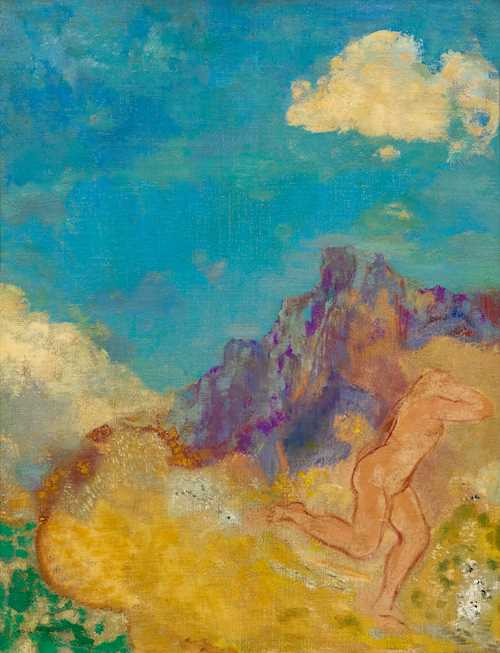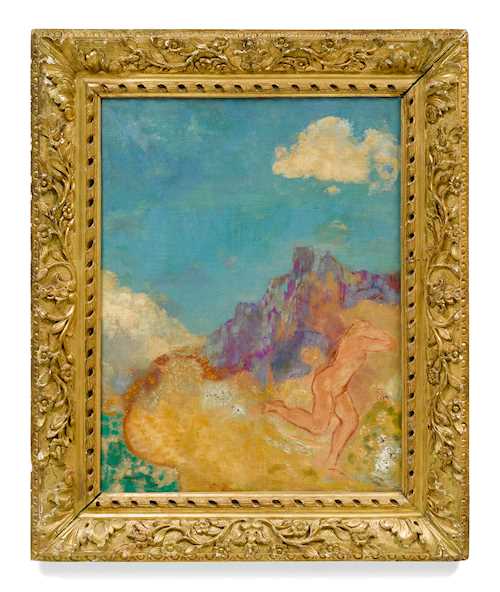
Lot 3217 - A201 Impressionist & Modern Art - Friday, 01. July 2022, 05.00 PM
ODILON REDON
(Bordeaux 1840–1916 Paris)
La Fuite. 1910.
Oil on canvas.
Signed lower left: Odilon Redon.
66 × 51 cm.
Provenance:
- Auction Duveen, New York, 30.4.–1.5.1952, lot 254.
- Galerie Fritz und Peter Nathan, Zurich.
- Private collection Bern, probably acquired from the above gallery.
- Swiss private collection.
Exhibited:
- Paris 1923, Exposition Odilon Redon, Galerie Druet, no. 29 (label on the reverse).
- Bern 1958, Odilon Redon, Kunsthalle Bern, 9.8.–12.10.1958, no. 189.
Literature:
- Alec Wildenstein: Odilon Redon, Catalogue raisonné de l'œuvre peint et dessiné, Paris 1994, vol. II, no. 780 (with ill.).
- Klaus Berger: Odilon Redon. Phantasie und Farbe, Cologne 1964, no. 79.
“What strikes me most in his work is the coming together of two almost opposite qualities: very pure plastic substance and very mysterious expression. Our whole generation is under his charm and benefits from his advice” (Pierre Bonnard in: Hobbs, 1977, p. 84).
Although Odilon Redon's work is contemporaneous with that of the Impressionists, it could not be more opposite. His oeuvre leans more towards the painting of the Symbolists, though it remains unique in art-historical discourse.
Redon's early works, the "Noirs", dark charcoal drawings with bizarre, sometimes terrifying mythical creatures, were produced in the 1870s and ‘80s and are an expression of a lonely and dark childhood. It was the birth of his son Ari in 1889 that prompted Redon to turn to colour and thanks to which he henceforth committed to pastels and oil painting.
After the turn of the century, Redon's painting was dominated by two themes: that of flora and that of religion and mythology . From the latter, the artist made use of a variety of subjects, ranging from the chariot of Apollo and heroes such as Perseus, to images of centaurs, Venus and the story of Pandora. Executed in 1910, "La Fuite”, belongs to the artist's mature oeuvre. It is unclear exactly which mythological figure the fleeing nude represents. Redon often painted female nudes within a landscape, but in each case he clearly titled them with the name of the depicted figure. Whether this is a Venus or simply a nymph fleeing from a god was obviously of secondary importance to Redon in the present work.
Instead, he is more concerned with capturing a fleeting moment. The artist usually developed his compositions out of the painted colour fields, which originated less from a planned composition than from an inner intention. The colours blend into a powdery, cloudy effect that, although painted in oil, resembles the pastel technique. Redon's use of colour combined with his deeply symbolic pictorial language would have a significant influence not only on the entire group of Nabis artists, but also on Matisse and the Fauvists, as well as Duchamp and the Surrealist movement. It is therefore not surprising that when asked about the influence of Cézanne on the art of his generation, Marcel Duchamp replied: "I am sure that most of my friends would say so and I know that [Cézanne] is a great man. Nevertheless, if I am to tell what my own point of departure has been, I should say that it was the art of Odilon Redon” (Rewald, 1961/62, p. 44).
CHF 250 000 / 350 000 | (€ 257 730 / 360 820)

